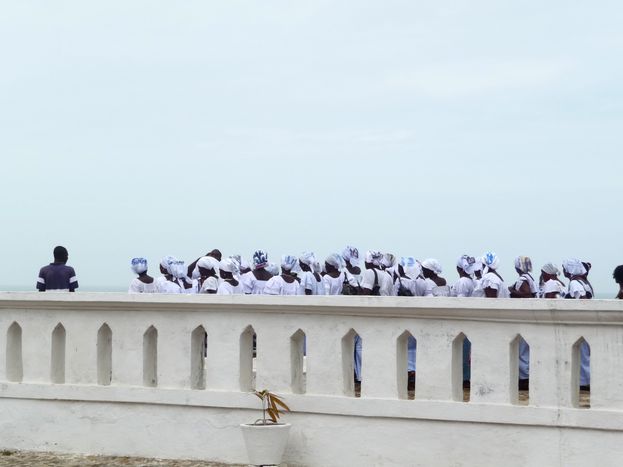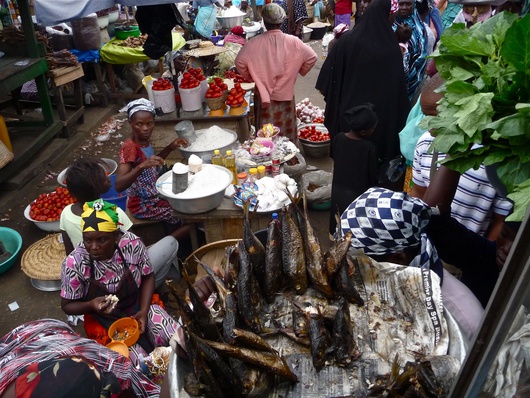
Getting to grips with djembe, tro-tro and obronis in Ghana
Published on
Translation by:
 Elaine Jordan
Elaine Jordan
I was told before I arrived in Ghana that everyone wants to speak to the foreigner or the obroni (‘white person’) as they say in Twi, one of the main dialects of the forty spoken in Ghana. I had several on the spot marriage proposals; but that’s Ghana and its people for you
I landed at Kotoka international airport in Accra, Ghana’s capital, in August. The first thing you find after clearing immigration and claiming your luggage are hundreds of smiling faces and embraces waiting to greet you. I realised then this was going to be an unforgettable experience. Located in western Africa, Ghana was the first countries to gain independence during the decolonisation of Africa in the mid 20th century. Nowadays, it remains one of Africa’s poorest countries, despite being extremely rich in natural resources.
Ghana fever
It’s essential before travelling to Ghana to get vaccinated against the likes of polio, rabies and typhoid fever as well as hepatitis A and yellow fever. On top of this, you need to take daily malaria tablets to avoid catching one of Africa’s most life-threatening diseases. Then, in with all this joy, you have the mosquitoes, constantly trying to outdo each other by seeing who can bite the most people. It’s pointless using repellent; if they want to attack you, they will. You can feel the dirt everywhere, probably due to the heat, the dust and the pipes spewing out waste onto the streets. Accra is a fascinatingly crazy place although if you want to get away from the heat for a few hours there are hotels like the Golden Tulip (one of the city’s best) where it’s possible to use the pool for 8 Ghanaian cedis (just under 4 euros or £3.64).
 Most foreigners can be found in the Osu district of the city. It’s here where anyone struggling with the African cuisine can get a decent pizza and a not so decent glass of wine at Mama Mia’s. In Buka the menu is made up of gourmet-sounding local dishes. There’s red-red (a dish of white rice and beans in a tomato sauce), chicken, banku (a dough mixture of corn and cassava in tomato soup with tilapia) and fufu (boiled and mashed cassava, plantain or yam). One of the best places for dancing is Bywell, with its live jazz and ‘hiplife’ (a mix of jazz, hip hop and afrobeat).
Most foreigners can be found in the Osu district of the city. It’s here where anyone struggling with the African cuisine can get a decent pizza and a not so decent glass of wine at Mama Mia’s. In Buka the menu is made up of gourmet-sounding local dishes. There’s red-red (a dish of white rice and beans in a tomato sauce), chicken, banku (a dough mixture of corn and cassava in tomato soup with tilapia) and fufu (boiled and mashed cassava, plantain or yam). One of the best places for dancing is Bywell, with its live jazz and ‘hiplife’ (a mix of jazz, hip hop and afrobeat).
Haggling in Nima and tro-tro transport
Nima is the capital’s muslim area. Wednesday here is market day, a treasure trove where visitors can discover millions of different goods. It’s organised chaos as women in traditional dress sell biscuits, water in small plastic bags, bread and exotic fruits, while, all the while carrying their children on their backs. There are adults and children, young and old everywhere, each one trying to live each day as it comes. The golden rule is always to haggle, a skill you can fine tune at the huge market, known as the arts centre. Here, westerners can buy masks, beads and t-shirts at dirt-cheap prices. It’s a place full of music studios where djembes (African drums) are made and where sometimes you stumble upon impromptu jamming sessions.
 There's a small tro-tro station (clapped out minibuses which are used as a cheap form of public transport) in the middle of the market. Getting to the coast is no easy feat when you are packed into tro-tros like sardines, often with very little air and having to carry your backpack for the entire journey from Accra to the Cape Coast. But it’s worth it to see the African tradition of women carrying goods on their heads, the sight of fish and meat for sale, being cooked by the roadside, the stunning landscape of endless cornfields, huge trees and dirt tracks interspersed with tarmac roads. Cape coast castle was one of the colonial era’s slave trade centres and is one of the eleven fortresses in Ghana declared a world heritage site by Unesco in 1979. Seeing the cells where slaves were kept imprisoned before being shipped out is a really moving experience. Crammed into cells with no light and virtually no food, the slaves were left too weak to try to escape. This is probably the country’s most popular tourist destination. From here you can carry on to Kakum national park with its seven rope and wood bridges spanning the never-ending precipices (not recommended for anyone scared of heights). Kakum offers a unique view of Africa’s fascinating wildlife. When you’re more than forty metres off the ground, you feel like you are walking through clouds.
There's a small tro-tro station (clapped out minibuses which are used as a cheap form of public transport) in the middle of the market. Getting to the coast is no easy feat when you are packed into tro-tros like sardines, often with very little air and having to carry your backpack for the entire journey from Accra to the Cape Coast. But it’s worth it to see the African tradition of women carrying goods on their heads, the sight of fish and meat for sale, being cooked by the roadside, the stunning landscape of endless cornfields, huge trees and dirt tracks interspersed with tarmac roads. Cape coast castle was one of the colonial era’s slave trade centres and is one of the eleven fortresses in Ghana declared a world heritage site by Unesco in 1979. Seeing the cells where slaves were kept imprisoned before being shipped out is a really moving experience. Crammed into cells with no light and virtually no food, the slaves were left too weak to try to escape. This is probably the country’s most popular tourist destination. From here you can carry on to Kakum national park with its seven rope and wood bridges spanning the never-ending precipices (not recommended for anyone scared of heights). Kakum offers a unique view of Africa’s fascinating wildlife. When you’re more than forty metres off the ground, you feel like you are walking through clouds.
Beachtime, lobsters and reggae in Takoradi
Two days later I board another tro-tro, this time bound for Busua Beach. It’s wonderfully peaceful here after the hustle and bustle of Cape Coast. The tro-tro drops us off at Takoradi. Here, after haggling for an hour, we are told we would have to take a taxi. Ten drivers swoop around us like flies. We finally arrive at Busua Inn, easily the best hotel of my stay in Ghana. Although at 60 cedis (32 euros or £29) it is, by Ghanaian standards, a bit on the expensive side. But that’s the price you pay for a wonderful lobster dinner with red wine on the hotel terrace. It's definitely a night of luxury on this almost deserted beach.

Reggae music fans can head for the beaches of Labadi and Kokrobite. In Takoradi there’s a reggae night every Saturday at Hotel Milly’s Back Yard. Tourists and locals alike can dance to live music from 8pm until 2am. Along the beach you can hear songs from Bob Marley and other greats like Toots and the Maytals, Jimmy Cliff and Buju Banton. Afterwards, people sit round a camp fire until dawn playing the djembe whilst children dance to the rhythm of the drums. Every ethnic group in Ghana speaks its own dialect, although they have found a way of living and working together. It’s a democratic country with a growing economy and a sense of drive and optimism. It’s this drive, this rich culture, the endless smiles, happiness and kindness that make the Ghanaian experience a truly unforgettable one.
Images: © Sofía Verzbolovskis/ Youtube video: ©joppu7
Translated from Ghana, el sabor de África a bordo de un tro tro


